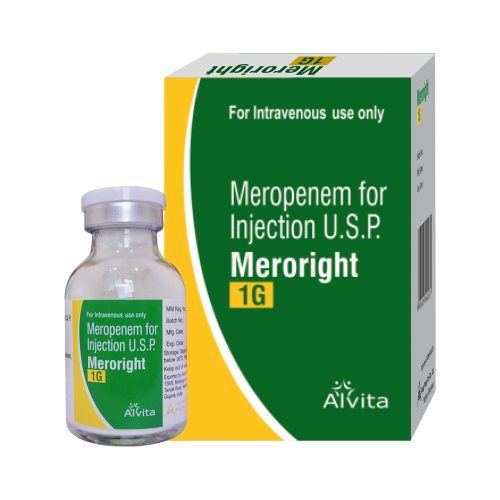
Meroright 1g Injection
Therapeutic Class
Carbapenem
Indications
Meropenem is indicated for the treatment of the following infections in adults and children over 3 months of age • Pneumonia, including community acquired pneumonia and nosocomial pneumonia. • Broncho-pulmonary infection in cystic fibrosis • Complicated urinary tract infection • Complicated intra-abdominal infection • lntra- and postpartum infections • Complicated skin and soft tissue infections • Acute bacterial meningitis Meropenem may be used in the management of neutropenic patients with fever that is suspected to be due to a bacterial infection. Consideration should be given to official guidance on the appropriate use of antibacterial agents.
Chemical Composition
Each Vial contains: Sterile Meropenem Trihydrate USP equivalent to anhydrous Meropenem 1 gm Sodium Carbonate equivalent to sodium 90.2 mg
Packaging
1’s vial/ pack
Dosage & Administration
The tables below provide general recommendations for dosing. The dose of meropenem administered and the duration of treatment should take into account the type of infection to be treated, including its severity, and the clinical response. A dose of up to 2 g three times daily in adults and adolescents and a dose of up to 40 mg/kg three times daily in children may be particularly appropriate when treating some types of infections, such as nosocomial .infections due to Pseudomonas aeruginosa or Acinetobacter spp. Additional considerations for dosing are needed when treating patients with renal insufficiency (see further below). Adults and Adolescents: infection Dose to be administered every 8 hours Pneumonia including community-acquired pneumonia and nosocomial pneumonia. - 500mg or 1 g Broncho-pulmonary infections in cystic fibrosis - 2g Complicated urinary tract infections - 500 mg or 1 g Complicated intra-abdominal infections - 500mg or 1g Intra- and post-partum infections - 500 mg or 1 g Complicated skin and soft tissue infections- 500mg or1g Acute bacterial meningitis - 2g Management of febrile neutropenic patients – 1g Meropenem is usually given by intravenous infusion over approximately 15 to 30 minutes Alternatively, doses up to I g can be given as an intravenous bolus injection over approximately 5 minutes. There are limited safety data available to support the administration of a 2 g dose in adults as an intravenous bolus injection.
Contraindications
Hypersensitivity to the active substance or to any of the excipients. Hypersensitivity any other carbapenem antibacterial agent. Severe hypersensitivity (e.9. anaphylactic reaction, severe skin reaction) to any other type of betalactam antibacterial agent (e.9. penicillins or cephalosporins).
Warning & Precautions
The selection of meropenem to treat an individual patient should take into account the appropriateness of using a carbapenem antibacterial agent based on factors such as severity of the infection, the prevalence of resistance to other suitable antibacterial agents and the risk of selecting for carbapenem-resistant bacteria. As with all beta-lactam antibiotics, serious and occasionally fatal hypersensitivity reactions have been reported Patients who have a history of hypersensitivity to carbapenems, penicillins or other beta-lactam antibiotics may also be hypersensitive to meropenem. Before initiating therapy with meropenem, careful inquiry should be made concerning previous hypersensitivity reactions to beta-lactam antibiotics. lf a severe allergic reaction occurs, the medicinal product should be discontinued and appropriate measures taken. Antibiotic-associated colitis and pseudomembranous colitis have been reported with nearly all anti-bacterial agents, including meropenem, and may range in severity from mild to life threatening. Therefore, it is important to consider this diagnosis in patients who present with diarrhea during or subsequent to the administration of meropenem. Discontinuation of therapy with meropenem and the administration of specific treatment for Clostridium difficile should be considered. Medicinal products that inhibit peristalsis should not be given. Seizures have infrequently been reported during treatment with carbapenems, including meropenem. Hepatic function should be closely monitored during treatment with meropenem due to the risk of hepatic toxicity (hepatic dysfunction with cholestasis and cytolysis) Use in patients with liver disease: patients with pre-existing liver disorders should have liver function monitored during treatment with meropenem. There is no dose adjustment necessary.A positive direct or indirect Coombs test may develop during treatment with meropenem. The concomitant use of meropenem and valproic acid/sodium valproate is not recommended Meronem contains sodium. Meronem 500 mg: This medicinal product contains approximately 2.0 mEq of sodium per 500 mg dose which should be taken into consideration by patients on a controlled sodium diet. Meronem 1.0 g: This medicinal product contains approximately 4.0 mEq of sodium per 1.0 g dose which should be taken into consideration by patients on a controlled sodium diet.
Side Effects
ln a review of 4,872 patients with 5,026 meropenem treatment exposures, meropenem-related adverse reactions most frequently reported were diarrhoea (2.3%, rush (1.4 %), nausea/vomiting (1.4 %) and injection site inflammation (1.1 %). The most commonly reported meropenem-related laboratory adverse events were thrombocytosis (1.6 %) and increased hepatic enzymes (1 .5-4.3 %). Adverse reactions listed in the table with a frequency of "not known" were not observed in the 2,367 patients who were included in pre-authorisation clinical studies with intravenous and intramuscular meropenem but have been reported during the post-marketing period. ln the table below all adverse reactions are listed by system organ class and frequency: very common (>1/10); common (>1/100 to 1/'1,000 to 1/'10,000 to < 1/10,000) and not known (cannot be estimated from the available data). Within each frequency grouping, undesirable effects are presented in order of decreasing seriousness.
Drug Interaction
No specific medicinal product interaction studies other than probenecid were conducted. Probenecid competes with meropenem for active tubular secretion and thus inhibits the renal excretion of meropenem with the effect of increasing the elimination half-life and plasma concentration of meropenem. Caution is required if probenecid is co-administered with meropenem.The potential effect of meropenem on the protein binding of other medicinal products or metabolism has not been studied. However, the protein binding is so low that no interactions with other compounds would be expected on the basis of this mechanism. Decreases in blood levels of valproic acid have been reported when it is co-administered with carbapenem agents resulting in a 60-1 00 % decrease in valproic acid levels in about two days. Due to the rapid onset and the extent of the decrease, co-administration of valproic acid with carbapenem agents is not considered to be manageable and therefore should be avoided Oral anti-coagulants. Simultaneous administration of antibiotics with warfarin may augment its anti-coagulant effects. There have been many reports of increases in the anti-coagulant effects of orally administered anti-coagulant agents, including warfarin in patients who are concomitantly receiving antibacterial agents. The risk may vary with the underlying infection, age and general status of the patient so that the contribution of the antibiotic to the increase in INR (international normalized ratio) is difficult to assess. lt is recommended that the INR should be monitored frequently during and shortly after co-administration of antibiotics with an oral anti-coagulant agent

